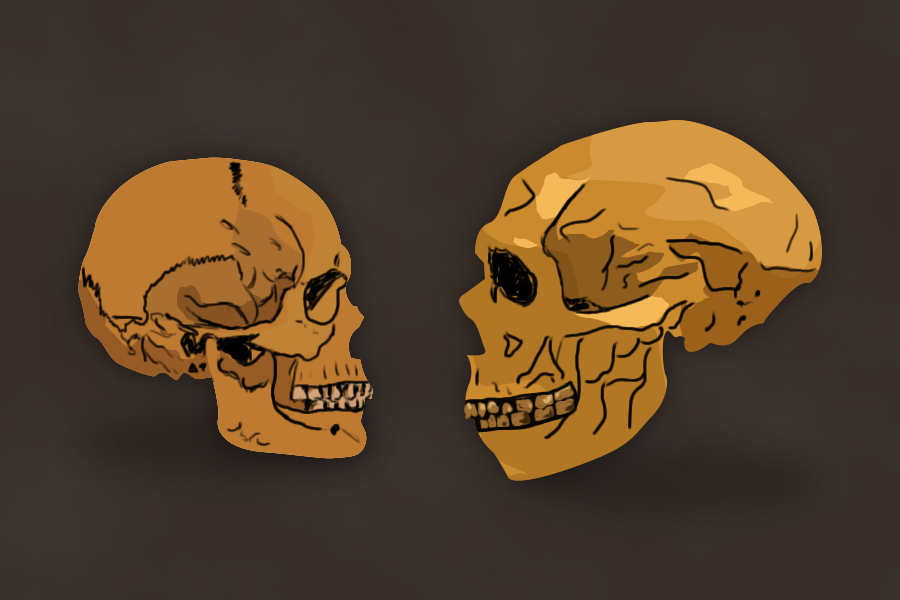
UC Davis researchers believe population size has driven natural selection in neanderthal, human hybrids
Nearly 40,000 years ago, neanderthals ceased to exist. Today, only a small fraction of their genes can be found in modern humans.
Previous studies hypothesized that a diminishing prevalence of neanderthal allele variants could be attributed to a genetic incompatibility between neanderthals and humans. That is, upon interbreeding, neanderthals and humans were not capable of producing an evolutionarily fit hybrid offspring.
However, researchers at the UC Davis have conducted a study that suggests otherwise.
“Our goal was to find out what could explain the observed level of neanderthal ancestry in the genomes of modern humans,” said Simon Aeschbacher, a postdoctoral student who spent two and a half years at UC Davis. “Previous studies have found that a certain percentage of our genomes is derived from neanderthals. It’s between one and four percent. Some people have more, some have less.”
In an effort to discover what caused the observed patterns of neanderthal genes in modern humans, Aeschbacher and a group of researchers relied on previous work that uncovered the sequence of the human genome. Upon recovery and sequencing of neanderthal DNA from Europe and Asia, the group of researchers at UC Davis were able to compare the sequences of neanderthal DNA with that of modern humans to see what pieces of the neanderthal DNA remained.
“Our explanation for why we see what we see, in terms of neanderthal ancestry in humans, is that differences in population size drove natural selection in neanderthal and human hybrids,” said Graham Coop, a professor in the UC Davis Department of Evolution and Ecology.
Variations in population size can cause natural selection to act differently. Natural selection acts more efficiently in larger populations where more variation exists. In smaller populations where individuals are more genetically similar, it takes much longer for natural selection to eliminate an unfavorable variation of an allele.
“When you have a small population, basically everyone is related to each other. This means that if someone has something that is slightly deleterious, then it’s highly likely that the others in the population will also have this bad allele just because they are all related,” said Ivan Juric, a population geneticist who previously worked with Coop and Aeschbacher. “Basically, it’s harder to remove this slightly deleterious allele from a smaller population. When you have a larger population, individuals are less related to each other. Because of that, they’re less similar. This allows for selection to be more efficient in removing these deleterious alleles.”
Natural selection works in a way that attempts to conserve the functions of the human genome. In regions of the genome where selection is very strong, a smaller quantity of neanderthal DNA will be found. In small neanderthal populations, certain alleles were able to persist due to individuals in the population being genetically similar.
However, when these neanderthal alleles were introduced into much larger human populations through hybridization, a type of purifying selection worked to efficiently remove these deleterious alleles in order to conserve the functions of the human genome.
It is important to note that not all neanderthal alleles are intrinsically deleterious or incompatible with those of humans. Really, the elimination of neanderthal alleles upon hybridization was due to differences in population size. If neanderthal populations had been larger, it is very likely that we would possess more of the allele variants they possessed.
“So, if the neanderthal population had been larger, selection in that population would be more efficient, so you would have fewer bad alleles. At the time of hybridization, fewer of these bad alleles would come into humans. If something is not deleterious, then it takes longer to be selected against,” Juric said.
Based off of the research they conducted, Coop and his team of researchers are now able to predict the future of neanderthal genes in the human genome.
“Our research would suggest that they [neanderthal allele variants] would further decrease in future generations,” Aeschbacher said. “The process would be very gradual, but our research predicts that neanderthal DNA will continue to be removed from the human genome.”
Written by: Abigail Saenz — science@theaggie.org



